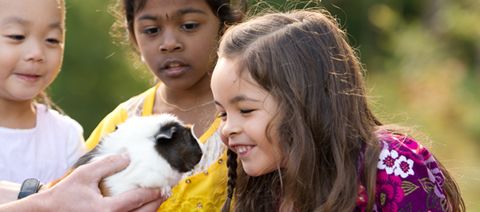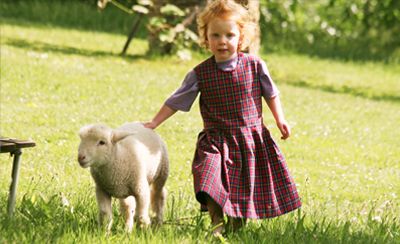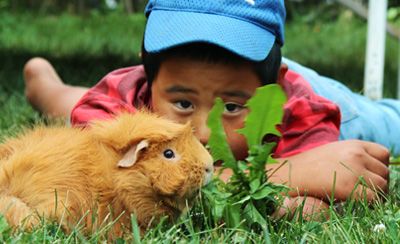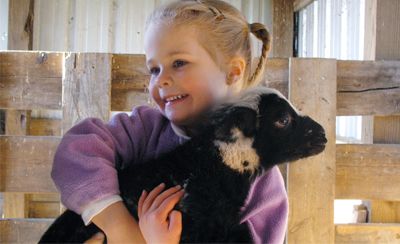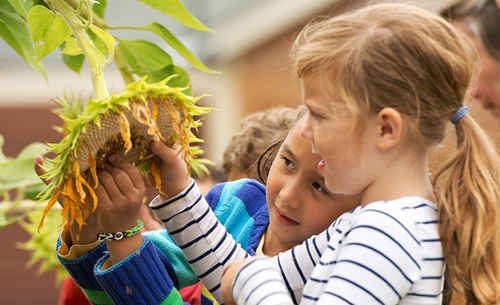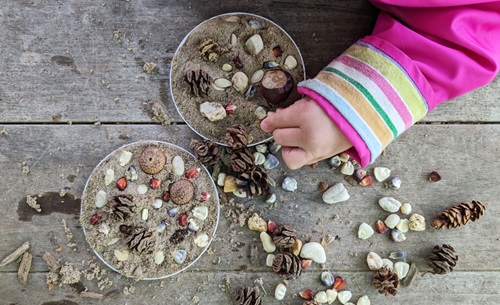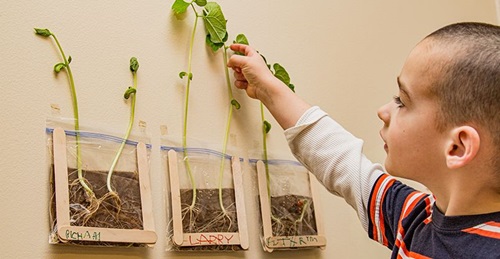Animals and Children: Valuable Connections
Understanding the value of connecting animals and children in early childhood.
|
November 2015
I have observed, as have many others, that something special seems to happen to children in the presence of animals. They are calmer, more curious, and more joyful.
Can children’s natural love for—and curiosity about—animals be dovetailed into meaningful encounters with animals in the classroom? Are encounters with animals really that important? Do they have any real impact on children’s development? Can early childhood educators provide children with meaningful connections with animals, even if they can’t have animals in the classroom?
Animals and Children
It’s been my experience, and the research certainly bears it out, that animals can help children develop sensitivity to others, they can offer comfort, and they can even provide a safe sounding board for secrets and feelings that children don’t share with adults. Animals provide opportunities for children to hone their social skills, practice care-giving and nurturing, and even to carefully explore issues of power and vulnerability.
Clearly, animals are important, and most adults recognize this. Not only do animals ignite cognitive curiosity, but they also evoke emotional responses in children. Just think about the delight a child shows upon seeing a chipmunk or a family of ducklings paddling across a pond, or the sheer joy she expresses when a colorful butterfly flits past. A few wasps approaching a group of preschoolers having a picnic may elicit screams and panic. Present that same group of children with a fluffy white puppy, and the explosion of delight will be almost palpable.
Whatever form a child’s love for animals takes, it’s obvious that animals are very special to children. Some children are more forthcoming about their love than others. Some children have lots of favorites, and others limit their love to just one or two. What seems to be universally true is that just about any child you ask will be able to tell you something he loves about animals. Ask a shy child what her favorite animal is, and she’ll open up right away. Children love to tell stories about their own pets, animals they’ve seen in the wild, special memories of the zoo, and other meaningful events. This alone tells us something basic and simple: animals are important and special to children.
Children share an innate need to associate with other living creatures.
Many people intuitively understand but perhaps have never heard of the “biophilia hypothesis,” the idea, put forward by biologist Edward O. Wilson in 1984, that humans have a natural affinity for other living things—plants, animals, and the natural environment. According to Wilson, because we are alive, we humans all share an innate need to associate with other living creatures. In recent years, many early childhood educators have recognized this need and are trying to embrace this philosophy in their centers by offering natural materials in the classroom (such as plants and planted flowers), creating nature-based play areas, and providing plenty of outdoor time for children. The biophilia hypothesis supports the idea that children can thrive when allowed extended periods of time in natural settings.
But having a biocentric approach to child development means more than just providing children with spaces to run and play in nature. It can also include opportunities for children to connect with living animals. Animals offer a unique window into another world. Children’s relationships with animals are special, rich with meaning, and supportive of children’s development. Focusing on children’s relationships with animals encourages and expands children’s affinity for living things.
Children’s innate love for animals seems to be universal. While most adults tend to place value on animals based on their relationship to humans (for example, valuing them for companionship, food, or products, such as leather or wool), young children seem to value animals simply because they are. This is called intrinsicvalue. Many children recognize the intrinsic value of animals not because of what they do for us, what they give to us, or how they help us, but simply because they are living creatures. Children don’t consider the elements and nuances of their relationships to, and love for, animals. Most simply love animals without question or analysis.
While the reasons that adults and children alike find animals so exciting and captivating may be rooted in our biology, psychology, or something else, there’s no denying animals’ widespread appeal. But what specifically about the animals makes them so special to children? Why are children universally drawn to animals?
Vulnerability
In a child’s world, adults rule. Adults make most of the decisions. They are the source of love, food, space, shelter, and the other basic elements of survival, pleasure, and comfort. Animals are the only living creatures that children can dominate. Although in our culture we often use the term dominatein a somewhat negative tone, I use the word here simply to mean “to have more power than.” This is neither good nor bad, it simply is.
The power of caring for an animal and playing a role in the animal’s well-being can be very meaningful for a young child. Especially in their early years, children are busy trying to understand how they are capable and competent. Giving children the opportunity to participate in meaningful caring activities for a vulnerable creature can build tremendous confidence.
The power of caring for an animal can be very meaningful for a young child.
Free Speech
Speaking with animals offers children a freedom that is not always felt when speaking to adults. Adults who are concerned with teaching and helping children develop their language skills can seem more focused on the mechanics of what the child is saying than the child’s message. Or some well-meaning adults try to help children “talk through” their problems or offer to help a child process his feelings. For children trying to navigate the already complex world of adult communication, these added pressures can discourage their speaking comfortably and freely.
In contrast, animals listen without question, without demand. They hear what a child has to say and don’t press her to say anything more. The family dog doesn’t ask a child to elaborate, reason, justify, apologize, or explain. He just listens. This can be very freeing for a child. Children know that they can tell a pet anything and it will be a safe secret. No matter how silly or insignificant a child’s feelings may seem, a receptive pet will never laugh, be dismissive, or minimize that child for having those feelings.
Exciting Abilities
Children also find the “magical” qualities of animals in stories and media appealing. Animals often have special powers. They can fly, see in the dark, move with extreme speed, live underwater, scare away monsters—things that children wish they themselves could do. In real life, animals also have special powers: echolocation, acute senses of smell and hearing, the ability to climb to the tops of trees, fly, hibernate, burrow underground, jump high, breathe underwater, walk on walls, hang upside down, and more! These exciting abilities make animals appealing and instantly captivating for children. Because they have special abilities, these animals hold children’s attention and can be great teachers.
Children’s love for animals and their many abilities can be expressed through pretend play. When children can play at being animals, they’re free of the limitations of being human! They imagine that they can climb the tallest trees and swing from vines and branches. They can fly in the clouds, swim in the deepest oceans, or strike fear into the hearts of weaker, smaller creatures. Playing with these fantasies is not only fun, but it can help children feel powerful and strong, too. It also helps children build empathy and compassion toward animals and other people and deepens their positive feelings for them.
Processing Feelings
For many children, animals, especially pets in the home, represent safety and security. They are familiar, they are safe to talk to, and they are a source of comfort and love. Because animals are appealing and reassuring, they are often a source of comfort that children will seek out to process their feelings. When my own children reacted with fear to a loud thunderstorm, it was comforting to them to see that the dog was also afraid. As our dog Nina paced around the bedroom and whined, the children spoke in soothing tones to her and petted her lovingly, even sharing their beloved blankies with her. Offering comfort to her seemed to help them find the inner resources needed to find comfort for themselves as well. The next time there was a thunderstorm, the children’s concern for Nina overshadowed their own fears about the thunder. They set to work trying to keep the dog comfortable and seemed to forget their own past fears.
Though they might not be able to explain it, children love animals for plenty of reasons. Animals can offer novel, multisensory experiences that are stimulating and powerful. They respond to children in ways that are familiar and easy to understand, yet also exciting and delightful. On a more subtle level, by acting as a sounding board, animals help children to explore feelings, direct their own life circumstances, and resolve their own struggles. And animals sometimes comfort children in a way nobody else can.
Animals are a source of comfort that children will seek out to process their feelings.
This article is excerpted from the Introduction and Chapter 1 of the book, Connecting Animals and Children in Early Childhood. The book goes on to discuss how animals impact the development of children, how to introduce authentic experiences with animals, and how to bring animals into your classroom.
Read the Book!
Selly, Patty Born.Connecting Animals and Children in Early Childhood. St. Paul, MN: Redleaf Press, 2014.

